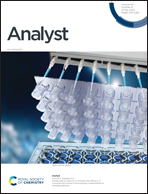Sensitive detection of fusion transcripts with padlock probe-based continuous cascade amplification (P-CCA)†
Abstract
Gene fusion, resulting from chromosomal rearrangements, is the juxtaposition of two or more original genes into the same set to form a functional gene. The significant specificity of fusion genes for tumor cells makes them promising candidates for diagnostic biomarkers and therapeutic targets. The sensitive detection of fusion transcripts is of great significance in biological research and disease diagnosis. Here, we propose a method for the sensitive detection of PML–RARα gene fusion transcripts by the direct ligation of the padlock probe at the junction site, and the cyclized DNA then triggers a continuous cascade amplification of two subsequent amplification reactions: rolling circle amplification (RCA) and loop-mediated isothermal amplification (LAMP). Due to the ability of the ligation reaction to differentiate mismatched sequences and the high amplification efficiency of continuous cascade amplification reactions, the proposed method can detect as low as 1 fM targets with high specificity, and has been successfully applied to real samples. Through a facile design of the triggering sequence in padlock probes, the cascade RCA and LAMP can be integrated into one-tube isothermal reactions with a simple one-step operation. Therefore, this work provides a convenient padlock probe-based continuous cascade amplification (P-CCA) method for the detection of fusion transcripts, and offers a fast and reliable platform for the early clinical diagnosis of gene fusion-related cancers.



 Please wait while we load your content...
Please wait while we load your content...